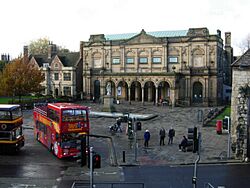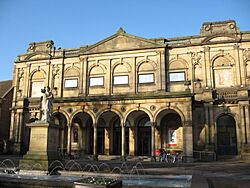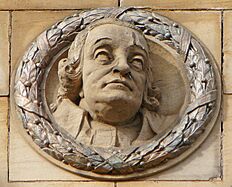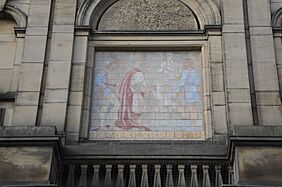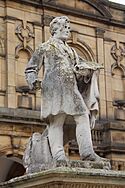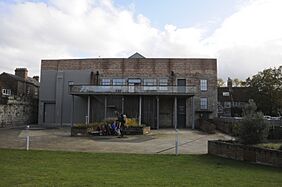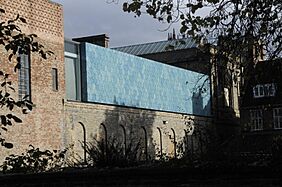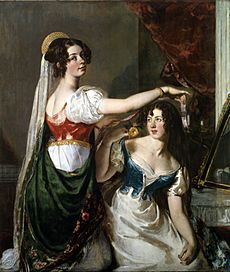York Art Gallery facts for kids
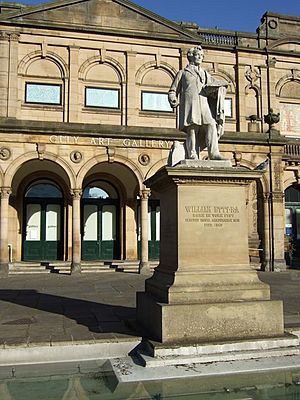
York Art Gallery and statue of William Etty
|
|
| Established | 1882 |
|---|---|
| Location | York, England |
| Type | Art museum |
| Accreditation | Arts Council England Accredited Museum |
| Key holdings | British Studio Pottery, Views of York, William Etty |
| Collections | Western European paintings, British paintings, prints, watercolours, drawings, ceramics |
| Visitors | 81,402 (2018–19) |
| Architect | Edward Taylor |
| Owner | York Museums Trust |
The York Art Gallery is a cool place in York, England. It's a public art gallery that shows off amazing art from the 14th century all the way to today. You can see paintings, prints, drawings, and even ceramics here.
The gallery closed for a big makeover in 2013 and reopened in the summer of 2015. The building itself is very old and special, known as a Grade II listed building. The York Museums Trust looks after it.
Contents
History of York Art Gallery
How the Gallery Started
The idea for the gallery came from a big art and industry show in 1879. People wanted a permanent place to show off art after a successful exhibition in 1866. That first show made a good amount of money, and the organizers decided to use it to build a lasting home for art.
A local architect named Edward Taylor designed the new building. He made many drawings between 1874 and 1878. The building first opened its doors on May 7, 1879.
The gallery was built in a garden area near the old St Mary's Abbey, York. It had an entrance hall, a main hall, and galleries for art. The outside was meant to be very fancy with stone figures, but they couldn't afford it. Instead, it got cool tiled pictures and roundels (round decorations) showing famous York artists like William Etty.
Behind the main building, there was a huge temporary exhibition hall. This hall was used for many events like concerts until 1909. It was finally taken down during the Second World War.
After the 1879 exhibition, the gallery wanted to have a permanent art collection. A collector from York, John Burton, helped a lot by leaving over a hundred 19th-century paintings to the gallery. In 1888, the north part of the gallery was used by the York School of Art.
York City Council bought the buildings and the art collection in 1892. In 1911, a big exhibition of art by William Etty was held. His statue was also put up outside the gallery.
World War II and Reopening
Before World War II, the gallery grew steadily. A big collection of prints and drawings of York was bought in 1931. When the war started, the gallery closed and was used by the military. It was even damaged by bombs in 1942.
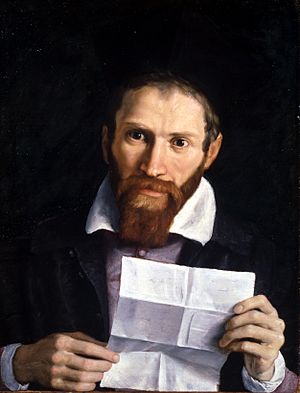
The gallery reopened in 1948. After a major repair in 1951–52, it really started to shine under a new director, Hans Hess. He helped the gallery get many important new artworks. In 1955, a huge collection of over one hundred old European paintings was donated. Thanks to these efforts, the gallery now has a strong collection of British art, especially from the late 1800s and early 1900s.
In 1963, the gallery received a special collection of studio pottery (handmade ceramic art).
Later Years and New Art
In 1979, a very old painting from the 1400s was stolen from the gallery. Luckily, it was found and returned to the gallery in 2023!
In January 1999, some valuable paintings were stolen from the gallery. The people responsible were caught, and the stolen artworks were returned.
The Gallery Today
The gallery had a big refurbishment in 2005, costing £445,000. It reopened on March 19. Another huge renovation happened from 2013 to 2015, costing £8 million. This made the display space much bigger, about 60% more! It also brought back the north wing and improved storage. The area behind the building was also opened up for public use as part of the York Museum Gardens.
When the gallery reopened in 2015, it started charging an entry fee for the first time since 2002. This caused fewer people to visit at first.
In 2020, during an exhibition by artist Harland Miller, special posters were sold. These posters became very popular and were even resold online for high prices! Also in 2020, the gallery added new artworks by British artists like Prunella Clough and Margaret Mellis.
The gallery closed and reopened several times during the COVID-19 pandemic in 2020 and 2021. It reopened for good on May 28, 2021, with a new exhibition. In January 2024, the gallery announced it would start charging for entry fees again. This was to help cover costs after a period of free entry.
Art Collection
Paintings
The gallery has over 1,000 paintings! You can see Italian altarpieces from the 1300s and works by famous artists like Annibale Carracci. There are also Dutch paintings from the 1600s and French art from the 1800s.
The British painting collection is also very strong. It includes portraits from the 1600s and 1700s, and works by artists like William Etty and Albert Joseph Moore. In 2025, artist Harland Miller donated three new paintings to the gallery.
Studio Pottery
The gallery has an amazing collection of British studio ceramics, with more than 5,000 pieces! These are handmade ceramic artworks by famous artists like Bernard Leach, Lucie Rie, and Hans Coper.
Works on Paper
This collection has over 17,000 drawings, watercolours, and prints. It's especially good for views of York, with over 4,000 examples. You can see works by famous watercolour artists like J. M. W. Turner and Thomas Girtin. The gallery also keeps the archive of artist William Etty.
Decorative Arts
There are over 3,000 decorative objects in the gallery. These include pottery from Yorkshire from the 1500s to the early 1900s. You can also find Chinese and Korean pottery and beautiful glassware.
Exhibitions at York Art Gallery
The gallery hosts many different exhibitions throughout the year. These shows can be big or small and often feature art from other places or special themes.
Awards and Recognition
York Art Gallery has won some cool awards!
- It won "Visitor Attraction of the Year" in 2016 from Visit York Tourism Awards.
- It was a finalist for "Museum of the Year" in 2016 by Art Fund.
- It won the "Family Friendly Museum Award" in 2016 from Kids in Museums.
- It was nominated for "European Museum of the Year" in 2017 and received a special commendation.


